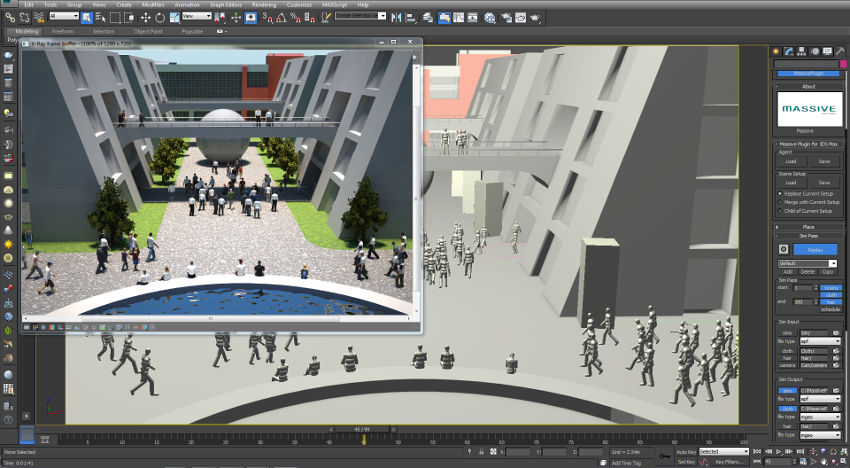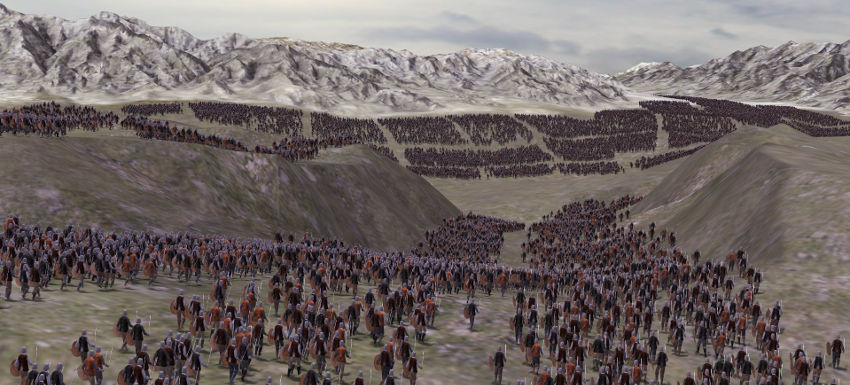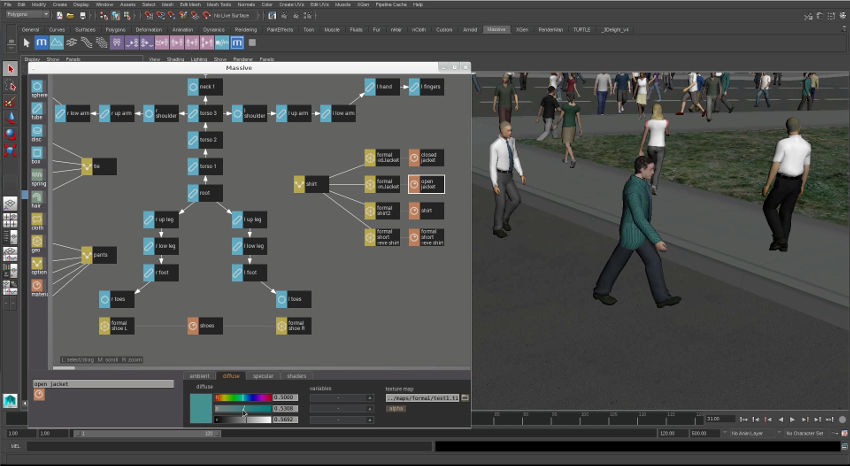Massive 8.0
Massive Software announces Massive 8.0 and Massive for Max at Siggraph 2015 in Los Angeles
3DS Max Support
The famous production proven quality of Massive will finally be available for 3DS Max users. "We know that 3DS Max users like to work within the Max environment so we are giving them what they've been asking for: a complete Massive plugin for 3DS Max." revealed CEO Stephen Regelous. "Some may recall an earlier announcement for upcoming 3DS Max support, and while the project was temporarily shelved we are now moving ahead with Massive for Max". The new plugin allows Max users to easily and conveniently create, simulate and render scenes of many thousands of characters and see the Massive agents in the scene just like any other 3DS Max objects. V-Ray rendering is fully integrated, and all the user has to do is click the render button to see the Massive agents rendered along with the other objects in the scene. The plugin is expected to be released along with Massive 8.0.

20,000 agents in realtime
Yes really. 20,000 agents at 24 fps on one PC. Inspired by Weta's Army Manager, which was used for on-set playback of crowd elements for The Battle of the Five Armies, we decided to find a way to run tens of thousands of agents in realtime in Massive. So now in Massive 8.0 it's possible to run simulations containing 20,000 agents or more at 24 fps on a single PC. These are not prerecorded simulations, and they do not use particles. This is a gigantic leap in efficiency with minimal compromises. The only special requirement is an NVIDIA Quadro K6000 or Titan X graphics card, to make it possible to render 20,000 agents at 24 fps with sufficient detail. Now previs crowd shots can be easily created in realtime. And on-set CG elements can include full, high-quality crowd elements that are truly indicative of the end result.

|
Parts |

|
Edit Agents inside Maya
In 2013 we introduced Massive for Maya, which is now used around the world for setting up, running, lighting and rendering Massive simulations, all inside Maya. Now in Massive for Maya 8.0 we've added the Massive editor window that allows for editing every aspect of agent bodies. Change any piece of geometry or texture map, adjust shader parameters, adjust rigid body dynamics settings, and add variation. This is bascially the same as a full Massive Jet license, all in the familiar environment of Maya, and still only $3500.

Polygon placement
Often it's advantageous to use reference geometry for agent placement in the scene. So we've improved our "geometry generator" placement primitive to allow for simple and powerful per-polygon agent placement. With Massive 8.0 a stadium shot of 100,000 agents can be accurately set up in seconds. This also works in Massive for Maya 8.0 and can instantly use any mesh in the scene.
Generator gaps
A much requested feature is the ability to insert gaps into agent placement. So now random gaps can be introduced using a simple slider.
Agents as terrain
Massive agents have always been good at adapting to terrain, and in Massive 8.0 we've introduced the ability for agents to walk over other agents, as if they were terrain. This is particularly useful when there are a lot of dead bodies in the scene. Another potential use would be insects crawling over eachother, like the Massive Wetas in King Kong.
Parent to terrain
It may be the San Andreas fault line coming apart or the ground falling away at the Gates of Doom. Whatever the scenario, when the terrain model is animated in multiple pieces it can be challenging to adapt agent performances to the wildly varying landscape. Massive 8.0 brings the ability to parent agents to individual pieces of terrain, providing much broader scope for compelling performances in situations in which the terrain model is animated.
Lanes parented to terrain
In keeping with the parenting of agents to animated terrain, Massive 8.0 also introduces parenting of lanes, for guiding agents around on the surface of the animated terrain.
Terrain file interpolation
When using sequences of geometry files as terrain, dynamics can become unstable. Massive 8.0 solves this by interpolating between geometry files on every step of the dynamics simulation, resulting in much more stable rigid body dynamics.
Scene nodes
Previously the scene page in Massive contained nodes for lights, cameras, terrain, agents, and groups. Now there are also nodes for placement generators, flow field splines, and lanes. This allows for much more convenient editing of scene layout, and greatly simplifies handling of complex scenes.
Action mirroring
Massive 8.0 brings action mirroring to the action editor. Now just a single click can generate alternative actions for variation. This feature can also be used to cut down on the number of actions required to be captured during motion capture sessions, saving time and money in the process.
Improved Lanes
Avoiding traffic collisions in the real world can be tricky, and getting agents to avoid collisions on lanes is no easier. So we added a new lane channel to make it easy to avoid collisions in complex traffic scenes, providing much more realistic traffic behaviour.
Render AOV's
Massive 8.0 supports rendering of separate "arbitrary output variables" or AOV's for each render pass. This can speed up rendering times, and streamline integrating Massive into studio pipelines. For example, a beauty pass and a shadow pass could be generated in one render and output to separate image file sequences. It can also be used to generate EXR files that contain an agent ID layer for identifying any misbehaving agents in dailies.
RenderMan RIS
Introduced by Pixar at SIGGRAPH last year, RenderMan RIS isn't so much a new version as a completely new renderer. So we wrote completely new renderer integration for prman 19 and onwards, taking full advantage of the new RIS rendering technology.
These and many more new features and improvements will be available in Massive 8.0 very soon.